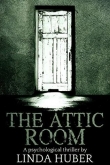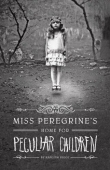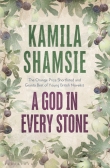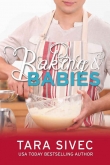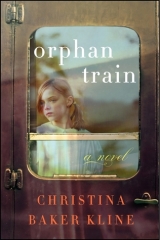
Текст книги "Orphan Train"
Автор книги: Christina Baker Kline
Жанры:
Историческое фэнтези
,сообщить о нарушении
Текущая страница: 18 (всего у книги 19 страниц)
P.S. Insights, Interviews & More . . .
About the author
Meet Christina Baker Kline
About the book
Christina Baker Kline Talks with Roxana Robinson
A Short History of the Real Orphan Trains
Reading Group Guide
About the author
Meet Christina Baker Kline

Karin Diana
CHRISTINA BAKER KLINE is a novelist, nonfiction writer, and editor. In addition to Orphan Train, her novels include Bird in Hand, The Way Life Should Be, Desire Lines, and Sweet Water.
Kline also commissioned and edited two widely praised collections of original essays on the first year of parenthood and raising young children, Child of Mine and Room to Grow. She coauthored a book on feminist mothers and daughters, The Conversation Begins, with her mother, Christina L. Baker, and she coedited About Face: Women Write About What They See When They Look in the Mirror with Anne Burt.
Kline grew up in Maine, England, and Tennessee, and has spent a lot of time in Minnesota and North Dakota, where her husband grew up. She is a graduate of Yale, Cambridge, and the University of Virginia, where she was a Hoyns Fellow in Fiction Writing. She has taught creative writing and literature at Fordham and Yale, among other places, and is a recent recipient of a Geraldine R. Dodge Foundation fellowship. She lives in Montclair, New Jersey, with her family. 
About the book
Christina Baker Kline Talks with Roxana Robinson
ROXANA ROBINSON is the author of Cost—named by the Washington Post as one of the five best fiction books of 2008—as well as three earlier novels, three short story collections, and the biography Georgia O’Keeffe: A Life. Four of these publications were New York Times Notable Books. Robinson’s work has appeared in The New Yorker, The Atlantic, Harper’s, Best American Short Stories, the New York Times, and elsewhere. She was named a Literary Lion by the New York Public Library and has received fellowships from the National Endowment for the Arts, the MacDowell Colony, and the John Simon Guggenheim Foundation. Her novel Sparta is forthcoming.
RR: Could you talk about how this book started? What gave you the idea for it?
CBK: About a decade ago, while visiting my in-laws in North Dakota, I came across a nonfiction book printed by the Fort Seward Historical Society called Century of Stories: Jamestown and Stutsman County, 1883–1983. In it was an article titled “They called it ‘Orphan Train’—and it proved there was a home for many children on the prairie.” My husband’s grandfather Frank Robertson and his siblings featured prominently in the story. This was news to me—I’d never heard of the orphan trains. In the course of researching this family lore, I found out that although orphan trains did, in fact, stop in Jamestown, North Dakota, and orphans from those trains were adopted there, the Robertson clan came from Missouri. But my interest was piqued, and I knew I wanted to learn more about this little-known period in American history.
RR: What was it that was most compelling to you about the idea of an orphan train?
CBK: I think I was drawn to the orphan train story in part because two of my own grandparents were orphans who spoke little about their early lives. As a novelist, I’ve always been fascinated with how people tell the stories of their lives and what those stories reveal—intentionally or not—about who they are. I’m intrigued by the spaces between words, the silences that conceal long-kept secrets, the elisions that belie surface appearance.
My own background is partly Irish, and so I decided that I wanted to write about an Irish girl who has kept silent about the circumstances that led her to the orphan train. I wanted to write about how traumatic events beyond our control can shape and define our lives. “People who cross the threshold between the known world and that place where the impossible does happen discover the problem of how to convey that experience,” Kathryn Harrison writes. Over the course of this novel, my central character, Vivian, moves from shame about her past to acceptance, eventually coming to terms with what she’s been through. In the process, she learns about the regenerative power of reclaiming—and telling—her own life story.
Like my four previous novels, Orphan Train wrestles with questions of cultural identity and family history. But I knew right away that this was a bigger story and would require extensive research. The vast canvas appealed to me immensely. I was eager to broaden my scope.
RR: Did you go to the Midwest to see any of the sites you describe here?
CBK: I’ve been going to Minnesota and North Dakota for decades. I know Minneapolis fairly well and feel a great affinity for the region. My husband’s family has a lake home near Park Rapids, Minnesota, and I’ve spent a lot of time there. Several of the small towns I describe in this novel are invented, as is Spruce Harbor, Maine, the setting for the present-day story. (Spruce Harbor is also the setting for another of my novels, The Way Life Should Be.) Planting an imaginary town in a real landscape gives me freedom as a writer to invent as I go.
RR: What sort of research did you do for the book, and did you interview people who were connected to the train? What was that like?
CBK: After finding articles online from the New York Times and other newspapers, I read hundreds of first-person testimonials from train riders, orphan-train reunion groups, and historical archives. That research led me to the New York Public Library, where I found a trove of original contemporaneous materials. I devoured nonfiction histories, children’s novels, and picture books, and conducted research at the New York Tenement Museum and Ellis Island. I also traveled to County Galway in Ireland to research my character’s Irish background.
In the course of writing this book I attended train riders’ reunions in New York and Minnesota, and interviewed train riders and their descendants. There aren’t many train riders left; those who remain are all over ninety years old. I was struck by how eager they were to tell their stories, to each other and to me. In talking to them and reading their oral histories, I found that they tended not to dwell on the considerable hardships they’d faced; instead, they focused on how grateful they were for their children, grandchildren, and communities—for lives that wouldn’t have been possible if they hadn’t been on those trains. I realized that in fiction I could do something that is difficult to do in real life: I could dwell on the stark details of the experience without needing to create a narrative of redemption.
RR: What was the most surprising thing that came out of the research? What was it that you hadn’t expected?
CBK: For decades, many train riders believed that the train they rode on was the only one. They didn’t know that they were part of a massive seventy-five-year social experiment. It wasn’t until their own children and grandchildren got involved and started asking questions (there are more than two million descendants, according to some estimates) that they met other train riders and began sharing their stories.
RR: You have two teenage girls as main characters, and though they are widely separated by time and circumstances, they share some things. Could you talk about that?
CBK: When you write novels, you go on instinct much of the time. As I began writing about Molly, a seventeen-year-old Penobscot Indian foster child, believe it or not, I didn’t immediately notice parallels to Vivian, a wealthy ninety-one-year-old widow. But as I wrote my way into the narrative I could see that in addition to some biographical parallels—both characters have dead fathers and institutionalized mothers, both were passed from home to home and encountered prejudice because of cultural stereotypes, both held on to talismanic keepsakes from family members—they are psychologically similar. For both of them, change has been a defining principle; from a young age, they both had to learn to adapt, to inhabit new identities. They’ve spent much of their lives minimizing risk, avoiding complicated entanglements, and keeping silent about the past. It’s not until Vivian—in answer to Molly’s pointed questions—begins to face the truth about what happened long ago that both of them have the courage to make changes in their lives.
RR: Can you talk about your own feelings of connection to Maine, a place you use often in your work?
CBK: Though both of my parents are Southern, we moved to Maine when I was six years old and never looked back. I’m not naïve enough to consider myself a Mainer—though two of my younger sisters might be able to, having been born in-state (Mainers tend to be inconsistent on this subject)—but I did spend my formative years in Bangor, a mid-Maine town of thirty-five thousand on the Penobscot River. About a decade ago my parents retired to Bass Harbor, a tiny coastal village on Mount Desert Island. My three sisters have houses within two miles of my parents’ home, and one lives there with her family year-round. I am lucky enough to spend summers and other vacations on the island; my three boys consider it their homeland. For me, it’s as simple as this: Maine is a part of who I am.
RR: Can you talk about the presence of time in this book, the way you use it to define and expand?
CBK: The present-day story in Orphan Train unfolds over several months and the historical section spans twenty-three years, from 1929 to 1943. It took some time to figure out how to balance the sections so that they complemented and enhanced each other.
Too often, when I’m reading novels with separate storylines, I find that I prefer one over the other and am impatient to return to the one I like. I tried to avoid this with Orphan Train by weaving the stories together so that they contained echoes of, and references to, each other—for example, Vivian’s grandmother gives her a Claddagh necklace in one section, and then pages later Molly comments on the necklace in the present-day story. But I didn’t want the references to be too literal or overt. It was complicated! I also wanted the historical section to end abruptly with a surprising revelation (which I won’t give away here), and for the present-day story to pick up where it left off, laying bare the mechanics of the storytelling: that Vivian is telling Molly her story in the present day. Sometimes I gave myself a headache trying to figure out how it all fit together. More than once, my editor, thank goodness, came in and saved the day. 
A Short History of the Real Orphan Trains
ORPHAN TRAIN is a specifically American story of mobility and rootlessness, highlighting a little-known but historically significant moment in our country’s past. Between 1854 and 1929, so-called orphan trains transported more than two hundred thousand orphaned, abandoned, and homeless children—many of whom, like the character in this book, were first-generation Irish Catholic immigrants—from the coastal cities of the eastern United States to the Midwest for “adoption,” which often turned out to be indentured servitude. Charles Loring Brace, who founded the program, believed that hard work, education, and firm but compassionate childrearing—not to mention midwestern Christian family values—were the only way to save these children from a life of depravity and poverty. Until the 1930s, there was no social safety net; it is estimated that more than ten thousand children were living on the streets of New York City at any given time.

Photograph courtesy of the Library of Congress Prints & Photographs Online Catalog, Lewis Wickes Hines Collection of the National Child Labor Committee.
Elizabeth Street in New York City, where Niamh lived, in the early twentieth century.

Photograph courtesy of the Library of Congress Prints & Photographs Online Catalog, Lewis Wickes Hines Collection of the National Child Labor Committee.
A bootblack like Dutchy, near City Hall Park, New York City, 1924.

Photograph courtesy of the Children’s Aid Society Archive, New York City.
A group of early-twentieth-century orphan-train riders with their chaperones.

Photograph courtesy of the Children’s Aid Society Archive, New York City.
Notices like this one were posted in the days and weeks before a train arrived in town.
Many of the children had experienced great trauma in their short lives and they had no idea where there were going. The train would pull into a station and the local townspeople would assemble to inspect them—often literally scrutinizing teeth, eyes, and limbs to determine whether a child was sturdy enough for field work, or intelligent and mild-tempered enough to cook and clean. Babies and healthy older boys were typically chosen first; older girls were chosen last. After a brief trial period, the children became indentured to their host families. If a child wasn’t chosen, he or she would get back on the train to try again at the next town.

Photograph courtesy of the Children’s Aid Society Archive, New York City.
A rare photograph of an entire trainful of children on its way to Kansas.

Photograph courtesy of the Library of Congress Prints & Photographs Online Catalog, Lewis Wickes Hines Collection of the National Child Labor Committee.
A young girl like Niamh/Dorothy, sewing to earn money.
Some children were warmly welcomed by new families and towns. Others were beaten, mistreated, taunted, or ignored. They lost any sense of their cultural identities and backgrounds; siblings were often separated, and contact between them was discouraged. City children were expected to perform hard farm labor for which they were neither emotionally nor physically prepared. Many of them were first-generation immigrants from Italy, Poland, and Ireland and were teased for their strange accents; some barely spoke English. Jealousy and competition in the new families created rifts, and many children ended up feeling that they didn’t belong anywhere. Some drifted from home to home to find someone who wanted them. Many ran away. The Children’s Aid Society did attempt to keep track of these children, but the reality of great distances and spotty record keeping made this difficult.
Many train riders never spoke about their early lives. But as the years passed, some train riders and their descendants began to demand that they be allowed access to records that until that time had been closed to them. One train rider I spoke with, ninety-four-year-old Pat Thiessen, told me that when, in her fifties, she finally got her birth certificate with her parents’ names on it, she shouted with joy. “I was so happy to know about myself, just a little,” she said. “It [still] feels incomplete. I keep wondering: What were my grandparents like? What did they have in my family that I could’ve enjoyed? Who would I be? I think of all of these things, you know. I had a good home; I don’t mean that. But I always felt they were not my people. And they weren’t.” 

Photograph courtesy of the Thiessen family.
Train rider Pat Thiessen in 1920, dressed up for her first Easter with her new family in Minnesota.
Reading Group Guide
1. On the surface, Vivian’s and Molly’s lives couldn’t be more different, but in what ways are their stories similar?
2. In the prologue, Vivian mentions that her “true love” died when she was twenty-three, but she doesn’t mention the other big secret in the book. Why not?
3. Why hasn’t Vivian ever shared her story with anyone? Why does she tell it now?
4. What role does Vivian’s grandmother play in her life? How does the reader’s perception of her shift as the story unfolds?
5. Why does Vivian seem unable to get rid of the boxes in her attic?
6. In Women of the Dawn, a nonfiction book about the lives of four Wabanaki Indians that is excerpted in the epigraph, Bunny McBride writes: “In portaging from one river to another, Wabanakis had to carry their canoes and all other possessions. Everyone knew the value of traveling light and understood that it required leaving some things behind. Nothing encumbered movement more than fear, which was often the most difficult burden to surrender.” How does the concept of portaging reverberate throughout this novel? What fears hamper Vivian’s progress? Molly’s?
7. Vivian’s name changes several times over the course of the novel—from Niamh Power to Dorothy Nielsen to Vivian Daly. How are these changes significant for her? How does each name represent a different phase of her life?
8. What significance, if any, does Molly Ayer’s name have?
9. How did Vivian’s first-person account of her youth and the present-day story from Molly’s third-person-limited perspective work together? Did you prefer one story to the other? Did the juxtaposition reveal things that might not have emerged in a traditional narrative?
10. In what ways, large or small, does Molly have an impact on Vivian’s life? How does Vivian have an impact on Molly’s?
11. What does Vivian mean when she says, “I believe in ghosts”?
12. When Vivian finally shares the truth about the birth of her daughter and her decision to put May up for adoption, she tells Molly that she was “selfish” and “afraid.” But Molly defends her and affirms Vivian’s choice. How did you perceive Vivian’s decision? Were you surprised she sent her child to be adopted after her own experiences with the Children’s Aid Society?
13. When the children are presented to audiences of potential caretakers, the Children’s Aid Society explains that adoptive families are responsible for the child’s religious upbringing. What role does religion play in this novel? How do Molly and Vivian each view God?
14. When Vivian and Dutchy are reunited, Vivian remarks, “However hard I try, I will always feel alien and strange. And now I’ve stumbled on a fellow outsider, one who speaks my language without saying a word.” How is this also true for her friendship with Molly?
15. When Vivian goes to live with the Byrnes, Fanny offers her food and advises, “You got to learn to take what people are willing to give.” In what ways is this good advice for both Vivian and Molly? And in contrast, what are some instances when their independence helped them?
16. Molly is enthusiastic about Vivian’s reunion with her daughter but makes no further efforts to see her own mother. Why is she unwilling (or unable) to effect a reunion in her own family? Do you think she will someday?
17. Vivian’s claddagh cross is mentioned often throughout the story. What is its significance? How does its meaning change or deepen over the course of Vivian’s life? 
Visit www.AuthorTracker.com for exclusive information on your favorite HarperCollins authors.
ALSO BY CHRISTINA BAKER KLINE
FICTION
Sweet Water
Desire Lines
The Way Life Should Be
Bird in Hand
NONFICTION
The Conversation Begins: Mothers and Daughters Talk About Living Feminism (coauthored with Christina Looper Baker)
Child of Mine: Original Essays on Becoming a Mother (editor)
Room to Grow: 22 Writers Encounter the Pleasures and Paradoxes of Raising Young Children (editor)
About Face: Women Write About What They See When They Look in the Mirror (edited with Anne Burt)
CREDITS
Cover photographs: young girl © by Yolande de Kort /Arcangel Images; train door © by Marcus Appelt/Arcangel Images
Author photograph by Karin Diana
COPYRIGHT
This book is a work of fiction. The characters, incidents, and dialogue are drawn from the author’s imagination and are not to be construed as real. Any resemblance to actual events or persons, living or dead, is entirely coincidental.
ORPHAN TRAIN. Copyright © 2013 by Christina Baker Kline. All rights reserved under International and Pan-American Copyright Conventions. By payment of the required fees, you have been granted the nonexclusive, nontransferable right to access and read the text of this e-book on-screen. No part of this text may be reproduced, transmitted, downloaded, decompiled, reverse-engineered, or stored in or introduced into any information storage and retrieval system, in any form or by any means, whether electronic or mechanical, now known or hereinafter invented, without the express written permission of HarperCollins e-books.
FIRST EDITION
EPub Edition April 2013 ISBN 9780062101204
Library of Congress Cataloging-in-Publication Data
Kline, Christina Baker, 1964–
Orphan train : a novel / Christina Baker Kline.—1st ed.
p. cm.
ISBN 978-0-06-195072-8
1. Women—Fiction. 2. Orphan trains—Fiction. 3. Female friendship—Fiction. I. Title.
PS3561.L478O77 2012
813'.54—dc23
2012027409
13 14 15 16 17 OV/RRD 10 9 8 7 6 5 4 3 2 1




